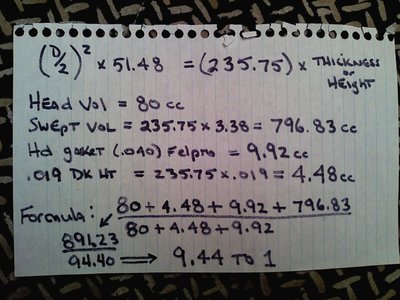Stegs
Well-Known Member
ok guys, for you engine builders. Im wondering if you can help me out to calculate my compression ratio of my 440
I will list all the specs that i know of my motor, hopefully you guys can chime in and see. I just came from a engine shop, I gave him this exact info, and he came up with something totally different than what i was told in the past
Here is a list of the parts, maybe you can help me out
69 440 block bored 30 over
pistons - part number 1263 1966-1971 dodge pistons flat tops federal mogol fm350Np (taller version / 9.5:1 pistons
cam elgin
valve lift .431
lift ex .429
duraton 282 intake, 296 exhaust
lobe center line 222
lsa 111 spread
stock 906 iron heads with stock valve, heads were shaved .005
stock bore and stroke
engine shop says total chamber cc is 104
chamber cc in head is 87 (88 from factory, minus the .005 resurface)
piston dome cc is 0
gasket thickness is .039
gasket bore 4.4
deck height (guessed at .03) as mopar hung them low
Let me know what you think!!
I will list all the specs that i know of my motor, hopefully you guys can chime in and see. I just came from a engine shop, I gave him this exact info, and he came up with something totally different than what i was told in the past
Here is a list of the parts, maybe you can help me out
69 440 block bored 30 over
pistons - part number 1263 1966-1971 dodge pistons flat tops federal mogol fm350Np (taller version / 9.5:1 pistons
cam elgin
valve lift .431
lift ex .429
duraton 282 intake, 296 exhaust
lobe center line 222
lsa 111 spread
stock 906 iron heads with stock valve, heads were shaved .005
stock bore and stroke
engine shop says total chamber cc is 104
chamber cc in head is 87 (88 from factory, minus the .005 resurface)
piston dome cc is 0
gasket thickness is .039
gasket bore 4.4
deck height (guessed at .03) as mopar hung them low
Let me know what you think!!
Last edited:

















